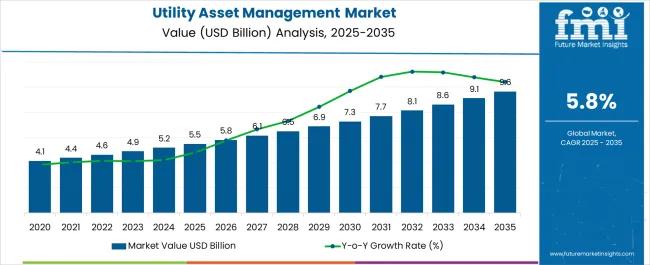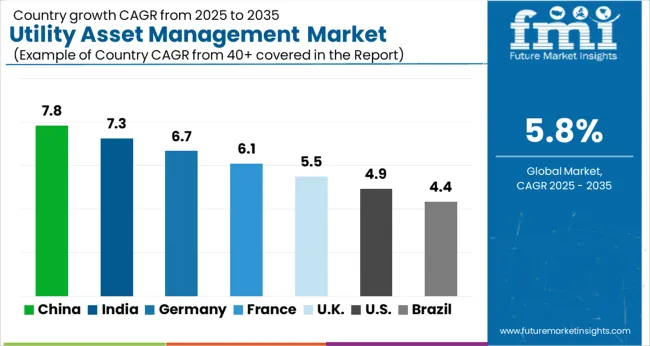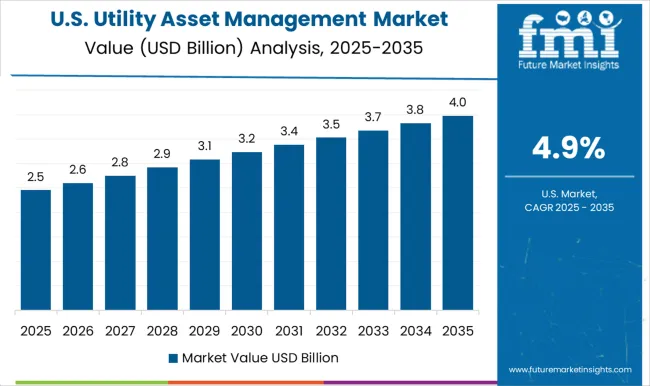The Utility Asset Management Market is estimated to be valued at USD 5.5 billion in 2025 and is projected to reach USD 9.6 billion by 2035, registering a compound annual growth rate (CAGR) of 5.8% over the forecast period.

| Metric | Value |
|---|---|
| Utility Asset Management Market Estimated Value in (2025 E) | USD 5.5 billion |
| Utility Asset Management Market Forecast Value in (2035 F) | USD 9.6 billion |
| Forecast CAGR (2025 to 2035) | 5.8% |
The utility asset management market is experiencing robust growth due to rising demand for efficient energy infrastructure, aging grid assets, and increasing regulatory pressures for reliability and sustainability. Utilities are prioritizing advanced asset management practices to optimize operational performance, reduce downtime, and extend asset lifecycles.
Integration of digital technologies such as IoT sensors, predictive analytics, and AI powered monitoring is reshaping asset management by enabling real time insights and proactive maintenance. Growing investments in renewable energy infrastructure and smart grids are also driving adoption as utilities seek to balance grid stability with increasing integration of distributed energy resources.
The outlook remains positive as governments and private stakeholders emphasize grid modernization and digital transformation, positioning asset management solutions as essential for resilient and sustainable energy operations.
The public utility type segment is projected to account for 54.20% of market revenue by 2025, making it the leading segment. This dominance is driven by the large scale infrastructure ownership and responsibility held by public utilities for delivering reliable power to urban and rural populations.
Strong regulatory oversight and the need for long term planning have encouraged public utilities to adopt advanced asset management systems. Their ability to allocate significant capital for modernization projects and integrate predictive technologies has further strengthened their leadership.
As public utilities continue to focus on reducing outages, enhancing customer satisfaction, and ensuring compliance, this segment maintains its position at the forefront of the market.
The hardware segment is expected to contribute 47.60% of total revenue in 2025 within the component category, establishing its dominance. This is supported by the growing deployment of smart meters, sensors, and monitoring devices that provide real time data on asset conditions.
Utilities rely heavily on hardware to enable digital asset management frameworks and facilitate predictive maintenance. Increased investment in grid automation and monitoring infrastructure has further fueled this growth.
As utilities prioritize physical modernization and digital connectivity, hardware continues to remain the cornerstone of asset management deployments.
The electric application segment is forecasted to hold 49.80% of market revenue by 2025, positioning it as the leading application. This dominance arises from the growing complexity of electric grids, rising energy demand, and rapid integration of renewable power sources.
Utilities have intensified focus on managing transformers, substations, and distribution networks to ensure reliability and efficiency. Digital asset management tools are increasingly deployed to prevent outages, optimize grid performance, and enhance safety in electric infrastructure.
With continuous grid modernization and emphasis on renewable integration, the electric segment remains the largest and most critical application area in utility asset management.
The utility asset management market attained a market revenue of USD 5.5 billion in 2025. The demand for utility asset management has witnessed healthy growth in the past few years. Key players in the industry have adapted to the strong demand for energy, enabling lower emissions, more renewable energy on the grid, and increasing plant productivity. The adoption of utility asset management has also been influenced by the rising demand for mission-critical software to improve water reliability and availability.
According to Future Market Insights (FMI) analysis, the utility asset management industry is anticipated to reach USD 9.6 billion by the end of 2035, registering a CAGR of 5.8%. FMI details the anticipated developments that are estimated to bode well for the market.
| Year | Expected Valuation |
|---|---|
| 2025 | USD 5.48 billion |
| 2035 | USD 6.49 billion |
| 2035 | USD 8.14 billion |
Short Term (2025 to 2025): In the short Term, the market is likely to benefit from the heightened demand for utility asset management in the oil and gas, power generation, and food and beverage/CPG sectors, among other sectors. The usage of utility asset management enhances productivity and minimizes the risk involved. In the power generation sector, the solution offers affordable, reliable, and cleaner electricity.
Medium Term (2025 to 2035): The industry is anticipated to be positively impacted by the growing adoption of utility asset management solutions to reduce outages and streamline maintenance. Further, regulators and citizens expect significant outcomes from utility asset management solutions. As a result, Environmental, Social, and Governance (ESG) measures are required to be ingrained into every business process and workflow. To leverage this momentum, utilities should cast themselves as businesses for a sustainable future.
Long Term (2035 to 2035): In the long run, the market is anticipated to be propelled by advancements in tools and technologies. A propagation of sensors offers an increasing variety of metrics with more frequency. New communications technologies allow quick data transmission from these sensors, while cloud computing extends the scope and pace of data analysis. With the help of Artificial Intelligence (AI), future behavior can be predicted from historical data. Such advances in technology open up doors for new possibilities to manage assets.
Based on type, the private utility sector accounted for a significant market share in the historical period. The sector is expected to lead the market in the forecast period. The accelerating investments to transform the grid to reduce power outage issues and extensive electricity networks of non-government companies are projected to propel segment growth over the forecast period. In addition, the deployment of utility asset management in private utilities to manage, monitor, and improve the functional ability of critical assets is estimated to enhance the segment scope. With the help of utility asset management, the asset life is prolonged, maintenance cost is reduced, and utility usage is alerted, along with many other benefits.
The software segment is projected to supersede the hardware and services segments. The high demand for software is the mounting requirement for mobile and remote detection, diagnostic tools, and inspection in far-reaching networks. As a result, key players in the utility asset management industry are launching advanced asset management software. For instance, IBM’s Maximo application suite is an integrated cloud-based platform that utilizes AI, IoT, and analytics to boost performance, reduce operational costs and downtime, and extend the lifecycles of critical assets. It further delivers enhanced reliability with inspection, AI-powered monitoring, and predictive maintenance systems.
The electric segment is slated to exhibit dominance over the forecast period. The electric segment is trifurcated into transformers, transmission and distribution systems, and substations. Out of these three, transformers are considered a crucial part of the power transmission network. Transformers constantly operate and require periodic maintenance and monitoring for an uninterrupted supply of electricity to end users and distribution centers. As a result, the demand for utility asset management from transformers is rising.
The management solutions have considerably incorporated the system to evaluate and optimize operating conditions, failure reduction, and life expectancy. Intensifying concerns related to the upkeep of reliable operations at reduced costs and the rising use of asset lifecycle planning, condition-based maintenance activities, and prediction are projected to support the growth of the electric segment.


The United States utility asset management industry is projected to be at the forefront over the forecast period. The complete electricity grid in the country includes low-voltage power lines and high-voltage power lines with transformers, connecting thousands of power plants to power consumers nationwide.
The country is concentrating on upgrading its current electricity grid to boost the electricity supply and minimize thermal losses caused by aging. In line with this, the United States government invested USD 5.5 billion in May 2025 to upgrade the country’s power grid capacity under the Transmission Facilitation Program (TFP) developed by President Biden’s Bipartisan Infrastructure Law.
Growth of regional market can also be attributed to the adoption of IoT sensors and surging digitalization in the utility sector. In addition to this, the high presence of key players in the country is offering ample growth opportunities for market growth.
China utility asset management market is projected to grow at a rapid pace over the upcoming years. The regional growth can be credited to the upgradation of power distribution infrastructure by installing automated tracking and monitoring systems. Further, the rising construction activities, urbanization, surging electric access, and rapid industrialization have led to an increase in electric transmission and distribution projects.
Several regional industries, such as chemical, automotive, petrochemical, and fertilizers, are demonstrating steady growth. This has resulted in high demand for electricity and proper upkeep of multiple components of an electricity grid. Reducing concerns related to distribution and transmission losses, along with the adoption of the Internet of Things to enhance efficiency in energy consumption, is anticipated to propel market growth in China.
Global players in the utility asset management industry are providing multiple products, services, and software to cater to the distinct requirements of an electrical power grid. Many companies are proactively functioning at regional and global levels to fulfil particular demands of the utilities.
| Attributes | Details |
|---|---|
| Forecast Period | 2025 to 2035 |
| Historical Data Available for | 2020 to 2025 |
| Market Analysis | USD million/ billion for Value |
| By Type | Public Utility, Private Utility |
| By Component | Hardware, Software, Services |
| By Application | Electric, Gas, Water |
| By Region | North America; Latin America; Europe; Asia Pacific; Middle East and Africa |
| Key Countries Covered | The United States, Brazil, Mexico, Canada, the United Kingdom, Germany, France, Spain, Italy, Russia, Argentina, Brunei, Cambodia, Indonesia, Laos, Malaysia, Myanmar, the Philippines, Singapore, Thailand, Vietnam, Australia, Poland, China, New Zealand, Japan, GCC countries, South Africa, others |
| Key Players | General Electric; ABB; Eaton; Siemens; DNV GL; Aclara Technologies; Sentient Energy; IBM; Hitachi Energy; Black & Veatch; ABS Group; Schneider Electric; IFS; Getac; Fujitsu; Lindsey Manufacturing |
The global utility asset management market is estimated to be valued at USD 5.5 billion in 2025.
The market size for the utility asset management market is projected to reach USD 9.6 billion by 2035.
The utility asset management market is expected to grow at a 5.8% CAGR between 2025 and 2035.
The key product types in utility asset management market are public utility and private utility.
In terms of component, hardware segment to command 47.6% share in the utility asset management market in 2025.






Full Research Suite comprises of:
Market outlook & trends analysis
Interviews & case studies
Strategic recommendations
Vendor profiles & capabilities analysis
5-year forecasts
8 regions and 60+ country-level data splits
Market segment data splits
12 months of continuous data updates
DELIVERED AS:
PDF EXCEL ONLINE
Utility-Scale Low Voltage Digital Substation Market Size and Share Forecast Outlook 2025 to 2035
Utility Markers Market Size and Share Forecast Outlook 2025 to 2035
Utility Electrical Conduit Market Size and Share Forecast Outlook 2025 to 2035
Utility Energy as a Service (EaaS) Market Size and Share Forecast Outlook 2025 to 2035
Utility Scale Switchgear Market Size and Share Forecast Outlook 2025 to 2035
Utility Based Medium Voltage Switchgear Market Size and Share Forecast Outlook 2025 to 2035
Utility Based Shunt Reactor Market Size and Share Forecast Outlook 2025 to 2035
Utility Terrain Vehicles Market Size and Share Forecast Outlook 2025 to 2035
Utility Scale Open Loop Current Transducer Market Size and Share Forecast Outlook 2025 to 2035
Utility Scale Transmission Substation Market Size and Share Forecast Outlook 2025 to 2035
Utility Scale Low Voltage Distribution Substation Market Size and Share Forecast Outlook 2025 to 2035
Utility-Scale Power Optimizer Market Size and Share Forecast Outlook 2025 to 2035
Utility Scale PV Inverter Market Size and Share Forecast Outlook 2025 to 2035
Utility-Scale Flexible Electrical Conduit Market Size and Share Forecast Outlook 2025 to 2035
Utility Scale Substation Market Size and Share Forecast Outlook 2025 to 2035
Utility-Scale High Voltage Digital Substation Market Size and Share Forecast Outlook 2025 to 2035
Utility Vehicle Market Size and Share Forecast Outlook 2025 to 2035
Utility Solar PV EPC Market Size and Share Forecast Outlook 2025 to 2035
Utility Scale High Voltage Power Transformer Market Size and Share Forecast Outlook 2025 to 2035
Utility Solar EPC Market Size and Share Forecast Outlook 2025 to 2035

Thank you!
You will receive an email from our Business Development Manager. Please be sure to check your SPAM/JUNK folder too.
Chat With
MaRIA